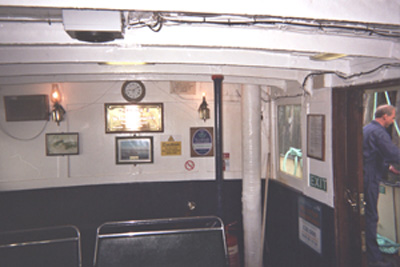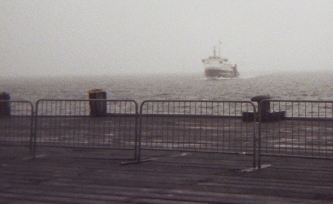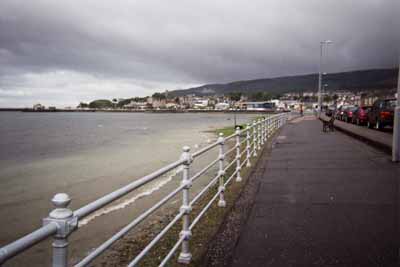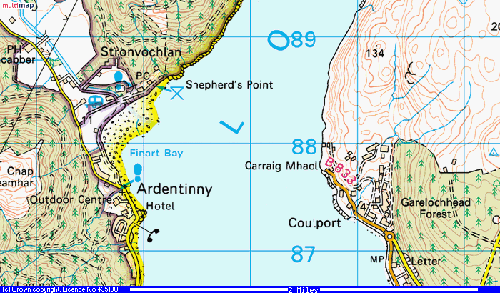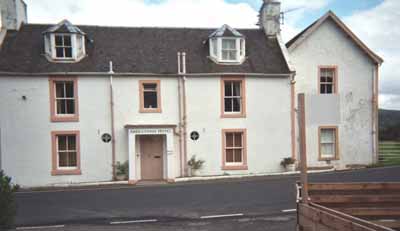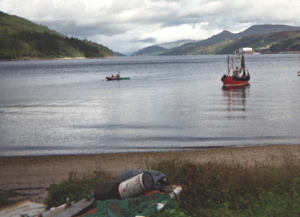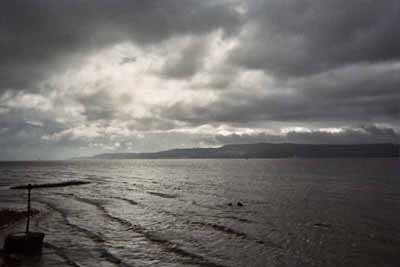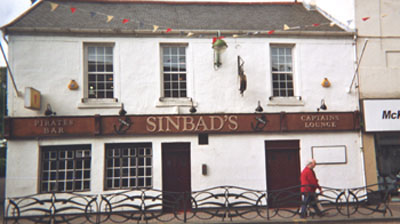Travelogue:Scotland
Argyll
From Balloch to Dunoon
Tuesday, August 29: The middle-aged male supervisor and 3 college age girls behind the counter at the Tourist Information Center in Balloch had convinced me that the only way to get across the Firth of Clyde from Balloch to Dunoon was to take the train back to Glasgow Central Station. There I could pick up another train that would take me to Gourock and the ferry terminal for all ships plying the routes of the Clyde Valley.
I was very much opposed to doing this. I hadn't battled the Atlantic waves ( albeit aboard an Icelandair jetliner ) to rediscover the muck and mire of a big city, and resisted the suggestion of returning to Glasgow, if only for an hour.
Later that evening, quite by accident, I happened to notice a map of the catchment area of the Clyde estuary, stuck up on a wall in the reception area of the Loch Lomond Youth Hostel. Ferries shuttling between Helensburgh and Gourock , and from there to Dunoon, were clearly indicated on the map by dashed and dotted lines. Helensburgh seemed to be accessible by local bus.
Returning to the tourist center the next morning I spoke with Angela, a girthy girl, (somewhere between the Heaviside calculus and a Chubbycheff Polynomial) , short, cute and friendly. (Judging from this brief visit, people in Scotland in general seemed very friendly. Even the Duchesse d'Antan is friendly, even if she is too busy saving mankind to give me more than a passing regard (mais quelle régard! ))
I persuaded Angela that passage to Dunoon via Helensburgh might work after all. Between her, myself and the Internet. we mocked out a complex strategy for getting to Helensburgh involving 3 buses. An early morning bus on the 31st of August would bring me to Balloch, there to catch the bus to Alexandria. At Alexandria I would have to change buses once again to get to Helensburgh.
Later that day I studied the schedules again and realized that if I missed a crucial connection in Alexandria, given all the parameters involved in transfering between buses and ferries, I couldn't expect to arrive in Dunoon before 5 PM ! Indeed, when I did finally arrive I discovered that, apart from pubs and restaurants, the town essentially closes down following afternoon tea, at 5.
I told this to Angela the next day, and she gave me the phone number of the bus company, McColl's . The man at the telephone desk for McColl's was very helpful. The bus from Balloch to Alexandria is the same one going on to Helensburgh. He recommended that I just stay on the bus. I passed this information to Angela. She thanked me and said that she now knew how to advise travelers who preferred picking up the ferry at Helensburgh to returning to Glasgow.
Advance to the morning of Thursday, August 31. When the reception office opened at 7:30 I made reservations for September 5th and 6th. Then I skirted ( or perhaps 'kilted') down the driveway to confront the murderous highway at the bottom of the hill: two tight lanes, no lights, no stop signs, no white stripes across the asphalt, a grey, dim obscurity through which one must discern the caravans of grey, grim trucks hurtling in both directions.
Throwing myself into the arms of fate I rushed across the road to the bus shelter on the other side. The bus arrived on schedule, at 8:10 AM, and I clattered aboard.
"Helensburgh!" I did not neglect to reinforce my confidence in this bold assertion with a cheery smile.
The driver stared at me with amazement. Pointing out the window to the back (Driving is done on the left in the UK, so he had to be using his right arm) he sternly indicated the bus shelter on the other side of the road.
"That's the bus you want, not this one . The bus to Helensburgh arrives in 35 minutes."
Another adventure crossing the deadly highway. The bus arrived, once more on time, and I was in Helensburgh in 15 minutes. Considerable time was lost searching for the docks, and I boarded the ferry to Gourock with minutes to spare.
The ferry pilot was a taciturn , embittered old salt - well, middle-aged salt at least - sour rather than ill-natured. He kept repeating the phrase " One pound, ninety" until I got the message. The co-pilot was very different: a Polish sailor, much younger, tall and stocky , self-assured, and helpful. I did manage to offend him, (not seriously) by asking him if he were Russian. Decidedly not! It should be obvious that he was Polish! .
Altogether I encountered six workers from Eastern Europe in my two weeks in Scotland: 2 Poles and 3 Hungarians, and the girl from Estonia. The European Common Market has succeeded in reforging links broken for a century or more.
The ferry chugged gently through the curdled waters of the Sound of the Clyde estuary like a tiny bird gliding across the extended palm of a giant hand. The wide eddies shed in the wake of the craft stretched far into the silvery mirror of the placid waters. Majestic panoramae of lofty mountains and mournful clouds wreathed in a magical mist formed from shifting masses of white and gray covered the horizon, all but immobile against the shifting landscape clothed in an argyle pattern of dull browns and greens. Huddled alone on a bench in the cabin below, I gazed through the water-soaked windows, with just enough drizzle to lend its suggestive aura of charm, studied the quaint old fittings, notices and decor of the walls of the passenger compartments, and allowed myself to be seduced into a state of happiness.
Interior of the Helensburgh ferry.
The Polish co-pilot is standing on the deck at the right
<
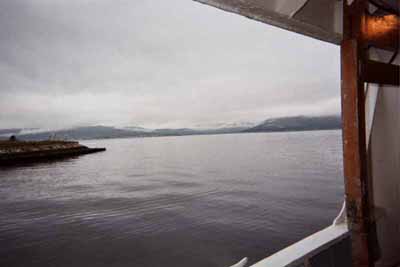
Firth of Clyde
All of this, combined with the knowledge that the Duchesse will inevitably be brought to ground, rendered me joyous and serene in ways I'd not been in many years. Latent memories from the distant past, perhaps even from past lifetimes, crowded busily in my mind. Above all, I now knew that I'd made the right decision in coming to Scotland.
Following a wait of about 15 minutes in the ferry terminal at Gourock , I joined a crowd of 50 or more passengers boarding a more capacious vessel, no longer a boat but full-fledged ship of the Caledonia-MacBrayne line the Iapadúr ("Jupiter" in twilight Celtic) that was destined to bring us to Dunoon.
Gourock: The Iapadúr appears through the horizon murk like a ghost ship.
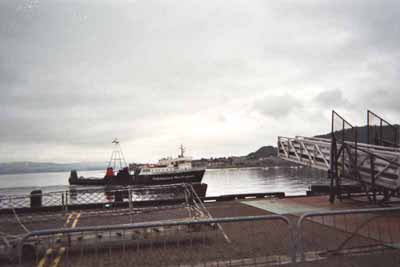
It pulls into the terminal.
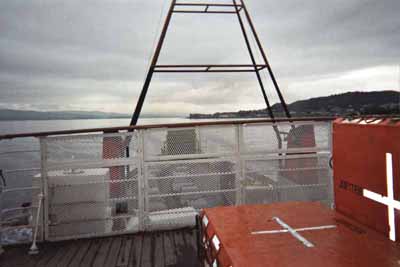
On board the Iapadúr
Land is sighted, 10:43 AM.
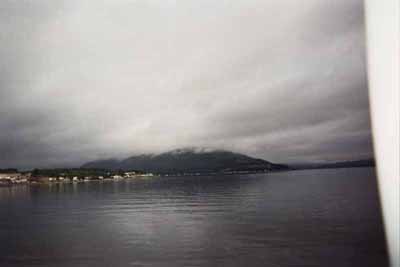
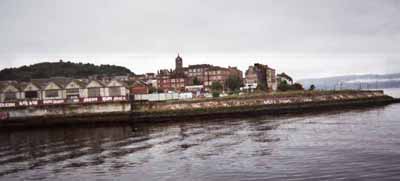
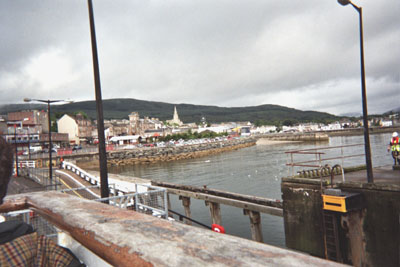
Dunoon
The coastal boundary of Dunoon village is girdled by a Boardwalk, protected from the beach by a concrete wall and metal fence.
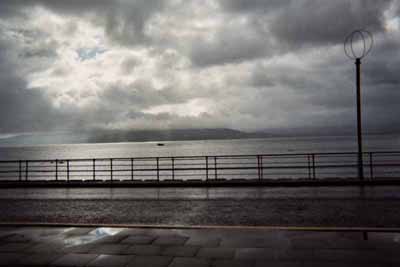
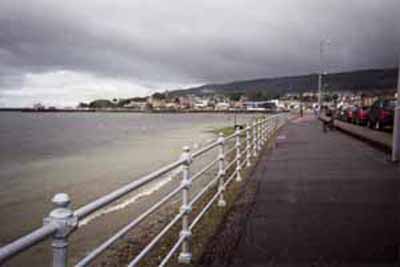
A wooden quai constructed from large rotting planks connects the ferry terminus, a fancy pagoda that recalls the resorts of an earlier time, with the downtown.
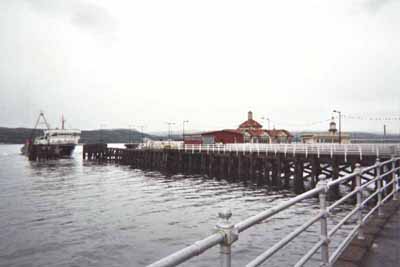
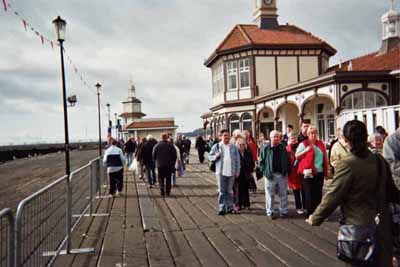
Dunoon, as I was to discover, is far more than a resort. It's a lively town, bustling with commerce. Its main throughfare, Argyll Street, is filled from one end to another with shops, restaurants, hotels and stores, selling everything from fine Scottish tweeds to household appliances to videotapes to Dunoon Rock Candy (the name of the town is incised within the long red caramel cane, and is best eaten with a hammer.)
I could not avoid the comparison with the pathetic state of my unfortunate homebase, Middletown, Connecticut. As, year upon year, it boasts of some fatuous "Renaissance", businesses in regular succession fold and move away, leaving a gapped frontage quite similar to the dentition of a victim of advanced peritoneal disease.
Leaving the terminal I walked along the quai to the Boardwalk, through a compartmented series of bus stations, up through a terraced walkway surrounding a bandstand and onto Argyll Street. Over to the right looms the facade of the Argyll Hotel, remarkable for its landmark visibility but not much else. ( Having once been, ( for several days!) the sole occupant of an entire suite in the fabled Carlton Hotel on the Croisette in Cannes, I can justify my snobbery!)
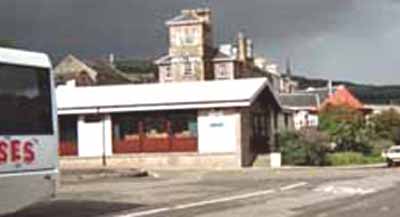
The Argyll Hotel
Like Balloch, nothing much happens before 10 AM, and the streets were just beginning to fill up. I'd deliberately organized my trip so that I would arrive a few days after the end of the Highlands Gathering, a kind of Scottish Mardigras featuring traditional athletic contests, bagpipe competitions, marches, dances, music and cuisine, uninterrupted festivities that, for a single weekend draws thousands of tourists to the town. Attendance at this event would have made fantastic copy for Ferment Magazine. There isn't any corporation, not even Halliburton, paying me for this travelogue and I don't like being trampled by tourists in the frenzy of their Bacchic revels. Given that the chances of finding a room would have been vanishingly thin, I'd seen enough of the climate to feel shy of passing the night on the beach in a sleeping bag. Maintaining a fragile survival between tides and tourists would have been exciting at best. At worst Ferment Magazine would have , predicated upon the loss of its lone writer, also lost the travelogue.
What this amounts to saying is that Dunoon was now comfortably in the off-off season. Consequently , as I was to discover, the cost of accommodations in most hotels and Bed and Breakfast establishments, was low. First things being first however, I was on the lookout for a place to take breakfast, usually pastry, sometimes bagels, with coffee. Yet, as I walked up Argyll Street my attention was arrested by the display window of a Hospice Charity Shop. Apparently it was not enough that I should have to replace all of my luggage and my shoes in the first few days of my arrival in Glasgow. I'd also lost my sweater and raincoat at the Youth Hostel there. If I wanted to wander about the countryside these items also needed to be replaced as soon as possible.

It turns out that Dunoon is amply supplied with charity shops where one can get clothing in excellent condition quite cheaply. A sweater cost me 1 pound. A few days later I brought a plastic rain covering for 2 pounds and an excellent all-weather jacket for 5 pounds, at a shop run for the benefit of Oxfam located in the historic old town of beautiful stone houses and walkways just above Argyll Street. A Red Cross shop and at least 3 other charity shops associated with local hospitals are on or near Argyll Street. It may not be necessary to bring any extra clothing with me when I return to Scotland. The clothes on my back may be enough. Everything else can be picked up in charity shops!
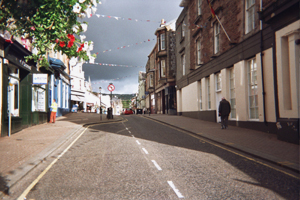
The Oxfam charity shop is on the left.
After giving the elderly woman behind the counter a pound coin for the sweater, I dropped another on in a collection box for the hospice - you never know when you may need one - and asked her to recommend a tearoom for coffee and pastry. She'd heard good comments about a bakery named Black's.
Walking up Argyll another block or so I ran into a familiar sort of character, wizened, withered, cranky and cantankerous, hobbling down the street on a cane. When I asked him to direct me to Black's, he admonished me:
"Ye donna wawnt te gou te Black's. Gou to the Craigen Tearooms up ther street. That's wair ye wawnte gou!"
He seemed to know his business so I walked up a little further and entered the opened door of the Craigen Hotel and Tearooms. Lesley Bishop, the hotel proprietor, was standing inside the doorway. The tearoom was just opening up and no customers had yet arrived. Sometimes one has the impression that heavenly forces are helping things along with a bit of cosmic encouragement. Serendipity, with its fortuitous license, had delivered me to the best hotel in all Dunoon for my projected stay of 5 days and nights. Over a snack of a sticky bun, bagel and coffee, Les and I arranged for an initial a two night stay at 25 pounds a night, breakfast included. He gave me the impression that the room wouldn't be available for more than two nights.
Later that afternoon I paid a visit to the Tourist Information Office on the coastal road. The woman there recommended a hotel called the Craigieburn for 20 pounds a night. It's some distance from the center of town. This might have had some merit if the downtown had been noisy, which it never is during the day. Up until 1 or 2 in the morning the neighboring pubs to the Craigen maintain a bawdy cacophony of music, banging and yelping. Compared to what I have to put up with in Middletown, this is essentially trivial. But the Dutch couple who manage the Craigieburn are pleasant and I gave them a £15 deposit for 3 nights.
When I told this to Les Bishop he reduced his room price to £22 pounds per night for my entire 5 night stay. I was able to go back to the Craigieburn and get my deposit returned the next day. Lesley and his wife, Mary run a superb guest house. The breakfast is more than ample. In its rooms they place all sorts of useful accessories, a hair dryer, electric water heater, tea bags, instant coffee, soap and shampoo, and television sets that actually work! At $44 a night one can wander the extent of the great American plenum and not find a motel that begins to equal the quality of accommodation at Craigen's Hotel: 15 Argyll Street, Dunoon Argyll, PA23 7DH Phone: 01369 702307 E-Mail: bookings@ craigenhotel.co.uk Note that this is not a paid advertorial.
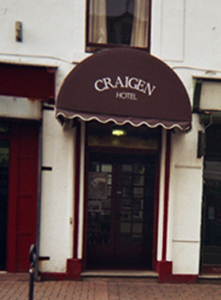
Front of the Craigen Hotel.
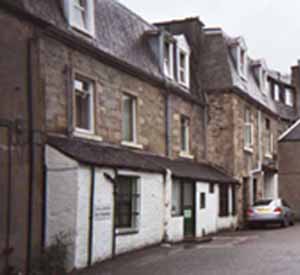
Back of the Craigen Hotel
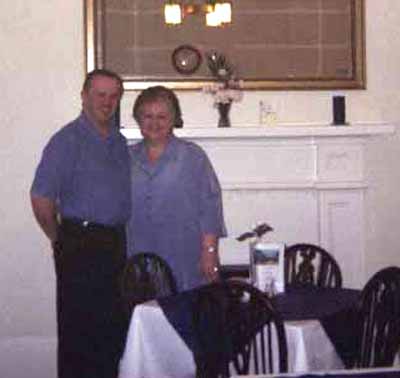
Les and Mary Bishop
Dinner at the Craigen Hotel is optional. It's a bargain at £8 and the cooking is good. I signed up for meals on the first and last nights of my stay there, leaving the remaining nights free to sample the local restaurants.
Dunoon Restaurants
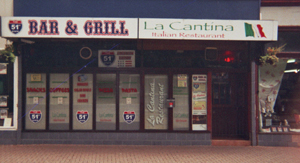
La Cantina, Italian food. Tacky ambience. Acceptable food and prices.
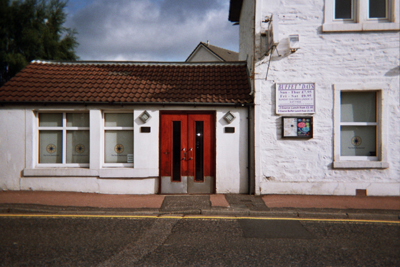
Lorne's pub. Top grades in all three categories.
My best experience with a restaurant in Dunoon was at "The Point", an Indian restaurant around the corner from the Tourist Information Office.
Les Bishop mentioned that 3 Hungarian laborers would be having dinner with us. One of them, whom I will call Lazlo, speaks a good English. He had interesting things to say and we all ended up eating together. The two others spoke no English. All of them were astonished when I proudly exhibited my 10 word Hungarian vocabulary, acquired during a visit to Nyerigyhaza in July, 1999. One can read about it at: Bolyai-Lobachevsky Conference, Hungary 1999
Hungarians abroad are accustomed to rarely finding anyone that speaks even that much of their language. Lazlo's English was picked up from living in Canada for 7 years. Not quite 7 years as it turned out : the government deported him shortly before the expiration of his visa. Lazlo liked Canada; he doesn't like Hungary. Indeed he gave us the impression that his loathing for Hungary is nothing short of visceral.
In Canada he met and married another Hungarian, a fully naturalized Canadian citizen. This counted for nothing to Canadian immigration. Lazlo was more or less told that if they allowed him to stay longer he would become addicted to Canada's (presumably superior ) way of life and never want to leave. The family was split up and he was forced to return to Hungary.
Wasn't the fact that his wife was a naturalized citizen enough to qualify for immigrant status and the equivalent of a green card? Yes, he answered, it was, but the procedural obstacles are so daunting that it would have cost him at least $15,000 in legal fees. He would still have to return to Hungary and fill out the forms for immigration from there, with no guarantee that they would be accepted. Fortunately his wife chose to follow him back to Hungary. She is no longer a Hungarian citizen, although she is still a Hungarian married to a Hungarian, which just shows that nationalism is dangerous and invidious nonsense; in any case the Hungarian government leaves them alone.
Lazlo tried to find work in Budapest but there was none for someone of his qualifications: he does skilled labor, something to do with glasswork. So he applied for work visas for countries in the European Union. Although Hungary and other Eastern European countries are now officially members of the Union, there is a pecking order among equals. Most of the Western European nations don't welcome Eastern European workers. He could not, for example, apply to work in Germany. The Western European partners can get cheap, slave labor from Africa and the Middle East, and are less than friendly to the notion that Eastern Europeans, because their countries now belong to the EU, would automatically have certain basic rights and privileges that cost employers money. The only EU countries with an Open Door policy for Eastern Europeans are Sweden, Ireland and the UK. A headline in the New York Times a few days ago indicates that even these countries are beginning to impose quotas.
Being fluent in English was clearly an advantage, and Lazlo readily found work In Scotland. Afterwards he brought over his two co-workers. ( Strangely, given the reputation of Hungarian as being incomprehensible to non-natives, he characterizes the Scottish accent as "gibberish"! ) He hasn't yet decided if he wants to stay on, perhaps apply for landed immigrant status. If he does, Scotland may be the beneficiary from these rejects of Canada.
Picturesque Scenes from Dunoon
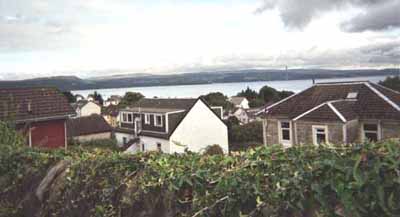
Dunoon's Houses
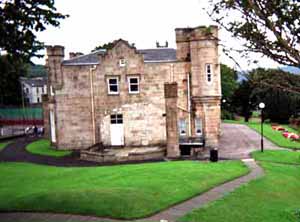
The Castle Museum combines local history, archaeology and anthropology
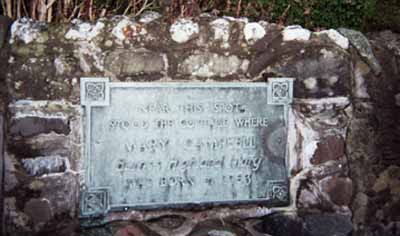
This plaque marks the location of the farmstead where Robert Burns' Highland Mary is said to have been born.
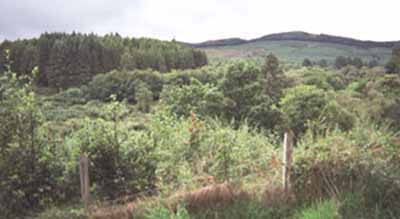
The Bishop's Glen
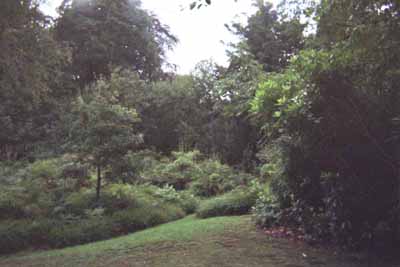
Morag's Glen
Ardentinny:
The Duchesse d'Antan was raised in Argyll, specifically the region known as the Cowal Peninsula. Her amorous entanglements on the beaches of Ardentinny as a wild teen-ager are the stuff of legend. A visit to Ardentinny was therefore at the top of the list of projects for this vacation. This map of Ardentinny has been lifted from Multimap.com :
The map gives one the impression that Ardentinny is a fully functioning village or town, with Hotel, Outdoor Center, Bay and a downtown shopping district . Notice Coulport on the other side of Loch Goil: this is where the American nuke subs were stationed for over 30 years. Today it harbors British nuke subs.
I boarded a bus from Dunoon that moved in a leisurely crawl up the highway along the shoreline. The bus took me through the towns of Kilmun, Sandbank, Strone, and Blairmore. Judging from the view through its windows, this is a region of considerable wealth. Rows of well-maintained stately houses fronting the beaches , with well-tended lawns and solid brick terraces , alternate with perspectives of rural landscape and magnificent sea-vistas.
Seeing a sign that said "Ardentinny Center" gave me reassurance that I would soon arrive at my destination. This is not what happened. The bus continued along the road until coming within sight of a park for trailers and caravans. Here it stopped. As I was the only person still on the bus, the driver informed me that he was taking a break before turning around to go back to Dunoon. Where did I want to get off?
In Ardentinny of course!
We'd passed Ardentinny, he said, half a mile down the road. I consulted my map, and indicated the location of the Ardentinny Hotel. That's all there is to it, he said, that plus a few dozen houses facing the shoreline. As it was only a short distance away and the weather was good, (that is to say that the rain was light and intermittent) I decided to get off and walk back . I could pick up the next bus back to Dunoon in an hour or so.
After ten minutes of walking, a few houses appeared on the left . Coming up on the right was the Ardentinny-Strone church, a charming structure which has the added advantage of maintaining a lavatory building off to the right. On a shelf inside the Men's Room stood a vase with freshly cut flowers. I was told later that the church sometimes puts out chocolates there as well.
Judging from the glass encased notice board on the road, this church fulfills every municipal function one normally expects in a town, meeting hall, civic center, concert hall, possibly post office and criminal court! The Ardentinny church in other words, is the Ardentinny downtown. As no minister or other notable metaphysician was on the premises I took some pictures and moved on.
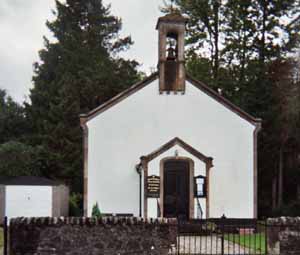
Ardentinny-Strone church
The "Outdoor Center" listed on the map is one of the two branches of a wilderness training school called "Actual Reality". ( The other is in Toward Castle) . I saw a few people walking around up there , but didn't think they could give me the information I was seeking. What could a wilderness adventure school have to teach the Duchesse that she didn't already know?
Another quarter mile or so and I was facing the Ardentinny Hotel.
The Duchesse is said to still have a few childhood friends on the staff of the hotel, with whom she stays in contact. It wasn't until 24 hours later that it occurred to me that I could have concocted a plausible story ( writer for the society page of the New York Times, always on the lookout for stories about royalty) for talking to them. Alas, I am not the nosey sort that is the stuff of a good muck-racking journalist. This exemplifies a general rule that never seems to fail: in every one of my professions, excellent qualifications notwithstanding, there is always some fundamental lack of a personality trait that keeps me from getting anywhere.
I now found myself entering upon a long stretch of beach, shielded from the highway by a stone wall. Little is here, in terms of water, beach or sunlight, to encourage sunbathing.
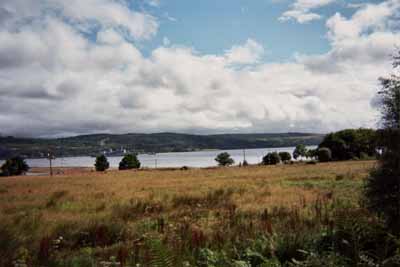
There isn't much more to the harbor at Ardentinny beyond what appears in this photograph.
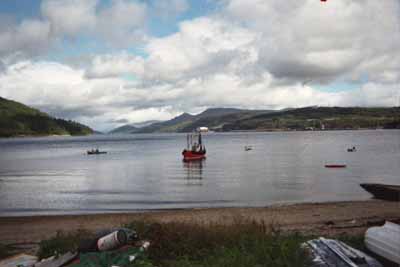
Still, as one can see, its not a bad place for polishing off a can of Budweiser.
The installations at Coulport are visible on the other side of the estuary. A piece of the above photograph has been enlarged to show the docking stations for the British Trident submarines which replaced the American Polaris submarines when they pulled out in 1992.
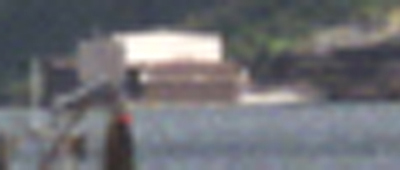
I doubt very much that the Duchesse was happy growing up less than a mile away from weaponry that can destroy 17 major cities at the push of a button. Her frenetic activity around the world in the service of political causes possibly originated here, through daily contact with the inhabitants of the CND protest encampments in Faslane, walking distance from Coulport up and across the neck of the peninsula.
At my right a row of elegant houses was shining splendidly , spread out facing the shoreline for a distance of about a third of a kilometer. My imagination pictured to me a few more homes going off into the woods; one way or another this was Ardentinny's lone residential neighborhood.
I am at a lose to understand why so many superlatives have been wasted on this all but uninhabited stretch of real estate. Ardentinny has been described by the Duchesse , in her usual extravagant manner, as "utter heaven". The publicity blurb for Actual Reality calls it a "a picturesque village". These remarks did not jibe with the scene unfolding before me. Across the estuary I could see the installations of a factory for nuclear waste functioning around the clock, which has been contaminating the waters lapping the shoreline for half a century. The beach itself is run-down and shabby. Rather than a municipality one has a block of houses, a hotel, church and wilderness adventure school ( which is probably a recent addition). There are indeed some beautiful perspectives of waters, mountains and clouds, but that's true throughout the entire Argyll region.
For once, the Duchesse's observations did not square with reality; then again, neither do my expectations. By the time I actually catch up with her, all my illusions may well be worn away. What, therefore, I ask you, is the point in persisting in my search for her? I have a ready answer to all who come to me with this argument: To Seek the Way is to already be On the Way .
Gazing across the estuary, my heart and mind oppressed by these sad reflections, I did not immediately notice a man coming down from the doorway of one of these houses, his tiny dog at the leash. 65 or so, a retired gentleman enjoying a sedentary existence in this out of the way settlement. He wore baggy unpressed trousers and a pale blue shirt. ( I myself never wear anything else but baggy unpressed trousers). He confirmed my suspicions that there were no more than 300 residents, all told, in the settlement circumscribed by the name "Ardentinny". When he learned that I was living on the east coast of the United States, he told me that he and his wife had been in the New York City area on September 11th, 2001, visiting their children in Long Island. They watched the unfolding catastrophe on television. They went into Manhattan a few days later. Of course the affected areas were off-limits to the public. We both agreed that the tragedy was not so great as the ways in which it has been exploited for wicked purposes.
After our brief conversation I continued down the road. In about 20 minutes a bus came by and took me to the Gallimaufry Galley in the town of Blairmore. I visited the Gallimaufry a few times during my stay and will describe it further on. In the meantime , one can visit its website at: Gallimaufry Gallery
Sinbad's Pirate Bar and Lounge
"Sinbad's Pirate Bar and Lounge" is on the West side of Argyll Street only a few buildings away from the Craigen Hotel
Sinbad's Pirate Bar and Lounge
The conventional way of spelling the name of the pirate from the Arabian Nights is "Sindbad". By removing the "d" the word becomes a concatenation of "sin" and "bad" . It is unlikely that the proprietors of this pub, were thinking of the literary possibilities of this alternative spelling; but the fact that they call their establishment a "pirate's lounge" indicates an equivalent intention.
My one visit to Sinbad's was motivated primarily by embarrassment: I didn't want to return to Connecticut and have to tell my friends that I'd not sampled, even once, a genuine Scotch whiskey in the land of its origins. I'm not a teetotaler, but pubs, taverns and bars give me the creeps. I'm much happier in French restaurants and cafes, where alcoholic drinks are served with one's meal without any fuss.
After a moment's hesitation, I took Resolution by the throat and marched Her inside. It will not win me the Pulitzer Prize to reveal that the interior was dingy, dark, foul smelling and suggestive of evil of every kind (well, not every kind; in fact only a few kinds. ) This was nothing less than what I expected, indeed far less that the quantity of "bad sin" that I' d both hoped for and feared. Once my eyesight adjusted to the dim light I was able to see that everyone, and I mean everyone, seated in this coal shuttle was an alcoholic.
I walked over to the bar counter at my left. In a few minutes a waitress appeared. I told her that I was a tourist from America who wanted to try some of the local brew to have something to satisfy the curiosity of friends when I got back. She suggested a malt whiskey. In a moment she was back with a shot of whiskey and canister of water. Then she walked me over to a table and sat me down.
The setting was lugubrious, the music and jangling lights of the television sets and neon advertising appropriately weird. My first sip of the Scotch malt was enough to convince me that it was indeed excellent. Cutting it with water made it last. Across from me at a neighboring table sat a young man. I estimated his age as early 30's. He regarded me with a friendly, if half- addled, stare. Soon he asked me to join him, which I did.
Two other persons were sitting with him. One was a somewhat older man. His countenance revealed both a wider experience with the world than my host, and a somewhat angry disposition. Between the two of them sat a girl, short of stature with an unkempt mop of platinum blond hair, late twenties or so. Totally ignoring my presence, ( why should she do otherwise?) she was pawing, groping, hugging and embracing the older man in a hysterical and exaggerated manner . I concluded that they were a couple, but one shouldn't jump to conclusions. From time to time she paused long enough from her disproportionate endorsement of her friend to bury her head in her hands, which she lowered to the table before bursting into sobs. My impression was that she had a splitting headache. Whatever the symptomology she was very sick from too much drinking, and suffering.
The person who'd invited me to their table didn't have much to say. He was curious to learn about Connecticut and bought me another Scotch. I realized that this had to be the last one, having discovered many times in the past that to get embroiled in buying rounds of drinks with alcoholics is not only immoral but a serious mistake.
The other man sized me up for awhile . Then he told me that he knew Connecticut well. I learned that he was a professional sailor working at the nuclear submarine bases in Coulport and Gaslane. Several years before he's been assigned to New London and Groton . He'd visited Hartford, Middletown, and New Haven. Later he was sent to a military installation in Iowa .
Between episodes of tussling with the young lady he rambled on about India and the Middle East, naming all the places he'd been to. Then he said something like: "I've got good friends among the Israelis", which shows that he'd been able to place me right away!
The next thing he did was thoroughly mysterious. For no discernible reason, he straightened himself up, puffed out his chest, and boasted: "Me, mujihadeen! Listen to me! I am a mujihadeen!" I was very happy when he stood up to go to the bathroom and pick up another drink at the bar.
While he was gone, my host made some innocuous comment to the girl that she took the wrong way, which may possibly help explain why she responded by throwing the contents of a water canister at his face and clothing . The incident caused a minor commotion at the tables against the walls, but it was soon over. The waitress and two male bartenders were instantly at our table. The man was handed a towel. Then the bartenders pulled her out of her seat and walked her to the door. The sailor returned. I asked him if she was his girl-friend. No, he'd never met her before, and had found her behavior as mysterious as the rest of us.
It was time to leave. I thanked my host for the gift of the second malt whiskey and made my exit. I'd done my duty, sampled choice brew in its native setting, and found no reason to return there or to any other bar. Lesley Bishop told me that the Sinbad was the worst pub in Dunoon and I'd done the sensible thing by leaving quickly.

